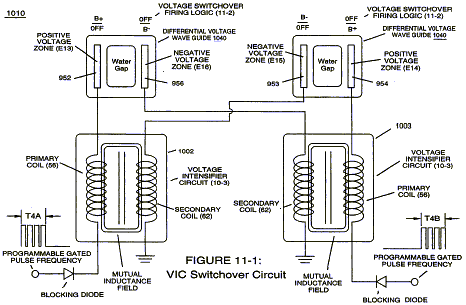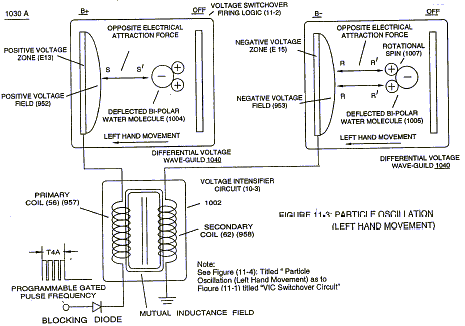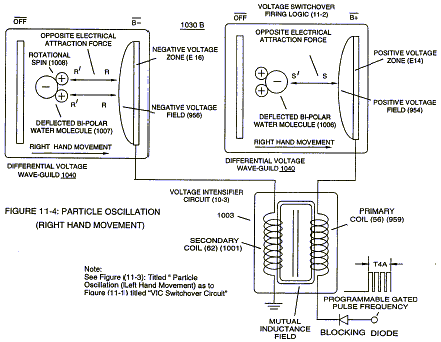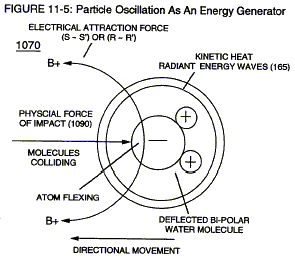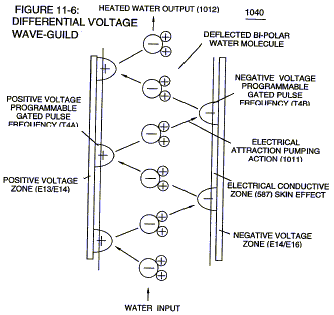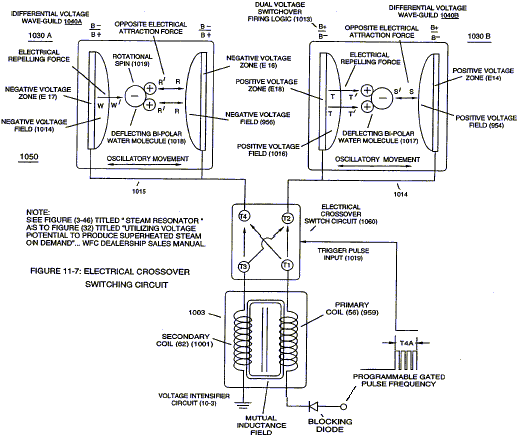MEMO 11, Memo WFC 430
http://users.skynet.be/fa272699/Energie/Meyer/memos/section11.pdf
WFC Steam Resonator ; Particle Oscillation as a Energy Generator
Flexing the atom as a energy generator is as basic as science itself … for without the atom having the capability to release energy our universe would not exists as we know it.
Atoms can be “Flexed” in many different ways to release a certain/given type of energy. Physical Stress being subjected to and undergoing Electrical Stress is by far the most dynamic way to cause the atom to go farthest from the point of state of equilibrium without atomic decay.
Electrical Stress brought on by opposite voltage polarity in a electronic circuit is extremely economical since applied voltage fields propagating opposite electrical attraction forces between the bipolar water molecule and the stationary voltage fields are not consumed In an electronic circuit when amp influxing is prohibited.
The Voltage Flexing Process to deflect the water molecule under both physical and electrical stress to emit thermal heat energy from the atom (s) of the water molecule under control state, is, now, to be presented by the utilization of the WFC Steam Resonator technology which incorporates the use of the Voltage Intensifier (VIC) Switchover Circuit to cause “Particle Oscillation” as a “Energy Generator:”
All energy in our physical universe (The third dimension) comes from a singular source … the atom. There are four basic forces that make up and effect the atomic structure: electrical force, electromagnetic force, weak and strong nuclear forces, and gravity. By either attenuating either one or more of these atomic forces, energy can be release from the atom to perform work in a variety of ways: such as, emitting photon, electromagnetic, or even radiant heat energy; Exposing the water molecule atom (s) to an external electrical attraction force (SS ‘/RR’) separately or combining the external electrical attraction force with an external electrical repelling force (SS’-TT’/RR’-WW’) can cause the bipolar electrical charged water molecule atom (s) to release thermal heat energy when physical impact (physical force) is achieved as a result of particle (s) colliding together under electrical stress which becomes and is the physical mover … causing electron bounce to oscillate the energy aperture of each atom of the water molecule.
Voltage Flexing Process
Particle oscillation as a “Energy Generator” by way of “physical impact” caused by a singular unipolar voltage pulse wave-form alternately polarity triggered is yet another method beyond the prior art to flex the water molecule to release thermal energy (Kinetic Energy) from the water molecule atom (s) without the need of gas combustion brought about by gas separation from water, as so illustrated in (1050) of Figure (11-5).
In order to accomplish this task, dual unipolar voltage pulse circuit (1010) of Figure (11-1) is, now, utilized to deflect (Physical Movement) the bipolar electrically charged water molecule (210) of Figure (3-46) while undergoing and experiencing both physical and electrical stress, simultaneously … causing atomic flexing of the water molecule atom (s) energy aperture (7) of Figure (5-1) which, in turns, releases radiant thermal heat energy (165) from the atom structure (s), as further illustrated in (450) of Figure (3-46).
As applied external opposite electrical attraction forces (S-S’) and/or(R-R’) as so shown in (1030) of figure (11-3) captures and electrically locks onto either the negative charged oxygen atom or onto the positive charged hydrogen atom (s) … whichever the case may be, the applied stationary voltage fields (952/E13 953/E14) or (954/E15 956/E16) alternately switch over periodically superimposes electrical stress forces (S-S’ and R – R’) onto the energy spectrum of the water molecule atom (s )(210) while physical flexing (951) of Figure (11-5) of the water molecule atom (s) occurs … disrupting the spin-velocity of water molecule atom (s) orbiting electrons (s) … forcing energy Apertures (7) of both unlike atoms of the water molecule (500) of Figure (5-1) and (510) of Figure (5-2) to be momentarily enlarged to a greater size (Particle flexing … called hereinafter Particle Oscillation), separately but simultaneously … allowing a greater amount of energy to enter into, travel through, and pass beyond the energy spectrum of each stimulated atom (s), respectfully … emitting the additive/surplus energy away from the excited atom (s) in the form of radiant thermal heat energy (165) when the flexed atom (s) (undergoing physical/electrical stress) returns to stable state of atomic equilibrium once applied electrical pulse-voltage wave-form (952 953) or (954 – 956) is electrically switch off and permitted to collapse back toward electrical ground state of zero volts (OV).
Repetitive formation of pulse voltage fields (952a xxx 952n) – 953a xxx 953n) or (954a xxx 954n- 956a xxx 956n) continues this “Voltage Energized Thermal Transference Effect” (1050) of Figure (11-5) (hereinafter called Atomic Flexing Process) during each and every pulse voltage on-time, as so illustrated by way of gated pulse-voltage waveform (1020) of Figure (11-2).
In essence, then, the continued flexing of a liquid or gas atoms being exposed to physical stress (954) by an external electrical attraction force (S-S’ IR-R’) is, herein, a more effective way to induce and propagate “Particle Oscillation” as an “Energy Generator” since voltage potential of opposite polarity poses a greater “Differential of Potential” over the prior art. (See Memo WFC 429 titled” Optical Thermal Lens” as to Memo WFC 424 titled “Atomic Energy Balance of Water” for further references).
VIC Switchover Circuit
VIC Switchover Circuit (1010) of Figure (11-1) is utilized to bring about Voltage Flexing Process (1050) by preventing amp influxing into and away from the separate and periodically spaced ( -) voltage zones (E13-EI4 – E15-EI6) of diagram (1030) of Figure (11-3) as to (1010) of Figure (11-1); while, at the same time, allowing voltage potential of opposite electrical attraction forces (S-S’ /R-R’) to perform work by deflecting the bipolar electrical charged water molecule (210) in a given directional pathway, as so in accordance to/with Coulomb’s (EqI2) and Newton’s second law of electrical force (Eq13) in an electrical/electronic circuit.
When incoming programmable gated pulse-frequency waveform (T4A) of Figure (11-2) electrically energizes primary input coil (957) of Figure (11-3) to produce positive voltage field (952) across voltage zone (EI3), the bipolar electrical charged water molecule having a negative charged oxygen atom is deflected and moved toward stationary positive voltage plate (E13) due to the opposite electrical attraction force (S-S’) that exists between both opposite electrically charged entities. Whereas, in like manner and in the same instant of time, stationary negative voltage field (958) attracts and displaces another and totally separate bipolar water molecule in an linear movement since opposite electrical attraction force (R-R’) also exists between stationary negative charged voltage plate (953) and the, now, moving positive charged hydrogen atom (s) being electrovalently linked to the negative charged atom.
The resultant physical displacement (physical movement) of both separate bipolar water molecule moves relatively at the same displacement velocity since both particle masses of the water molecule (s) are basically identical in volume-size and the electrical intensity on both stationary voltage fields (952/953) are similar due to the fact that both primary coil (957) and secondary coil (958) comprising and forming voltage intensifier circuit (990) of Figure (10-3) are together bifilar wrapped in equal length.
The simultaneously formation of both the positive voltage field (952) and the negative voltage field (953) is simply accomplished by the mutual electromagnetic inductance coupling field that is produced between the two bifilar wrapped coils (957/56 – 958/62) when the primary coil (957/56) is electrically energized by incoming voltage pulse train (T4a xxx T4n), as so illustrated in (970) of Figure (10-1).
Automatically, the self-inductance coupling (619a xxx 619n) of Figure (7-3) prevents amp influxing [restricting current flow into and away from water bath (68) during each pulsing cycle T4AIT 4B]. While, the distributed capacitance (Cda xxx Cdn) of each coil experiencing inductance coupling (619) elevates applied voltage level (Vn) to a higher voltage amplitude (increasing voltage intensity) required to deflect the bipolar water molecule to a given or preselected distance. Voltage intensity (952/953) is, therefore, directly determined by the number of turns of each coil (957/958) as to the applied voltage amplitude of incoming pulse-wave ( … xxx Vn) (1060) of Figure (11-2c). Voltage intensity as in terms of “Different of Potential” establishes the amount of work performed by the applied “Electrical Stress” to bring about molecule mass displacement of the water molecule in a liquid medium.
Electrically energizing Voltage Intensifier (VIC) Circuit (1002), now, causes both bipolar water molecules (1004/1006) to be deflected and displaced in a left-hand movement, as so illustrated in (1030) of Figure (11-3). To reverse direction of the line of travel of the deflecting water molecule from left-hand movement to right-hand movement, another and completely separate Voltage Intensifier VIC-Coil Assembly (1003) of Figure (11-3) is periodically switch-on electrically by alternate voltage pulse waveform (T4B) once first voltage pulse wave-form (T4A) is terminated for a’ brief period of time (T3A) … duplicating the electrical attraction force (S-S’ !R-R’) as before except both bipolar water molecule (s) (1004/1006) are, now, redirected and deflected in the opposite direction toward voltage fields (956/954), respectfully, as so illustrated in (1030) diagram (B) of Figure (11-3).
This continued and repeated oscillation of the bipolar water molecule (1004/1006) in opposite direction of linear travel (back and forth motion) produces kinetic energy (165) when the moving and deflected bipolar water molecule (1004/1006) or any other bipolar molecule of water interlocking with ever changing electrical attraction forces (S-S’ /R-R’) collides with neighboring water molecules present in the same water bath (68).
Electrically interfacing alternate “Switchover” voltage pulse wave-form (T4A/T4B) to each of both VIC Coil-Array (s) (1002/1003) of Figure (11-3) as schematically depicted, now, forms VIC Switchover Circuit (10lO) of Figure (11-1).
Pairing together positive voltage zone (EI3/952) with negative voltage zone (EI6/956) and doing the same with voltage-surfaces (EI4/953) to (EI5/954) as so graphically shown in (lOlO) of Figure (11-1) and each having an longitudinal axis of identical length, now, individually forms what is called hereinafter a “Differential Voltage Wave-guide”(1040) … being defined as heating water by alternate pulsation of opposite voltage fields at different pulse time-on periods, collectively called “Voltage Switchover Firing Logic (B+/O – B-/O – O/B – O/B+).
In Like manner as to linear cylindrical resonant cavity (730) of Figure (7-12), the Differential Voltage Wave-Guide (1040) of (1010) of Figure (11-1) as to Figure (11-6) is constructed in such a way as to allow a smaller tube to be placed inside a much larger tube having space relationship to allow water to pass there between, as so pictorially shown in (170) of Figure (3-25). The constructed tubular-Array is composed of T304 stainless steel material, or any equivalent thereof, which is chemically inert to the voltage deflecting process (lO50) of Figure (11-5).
The electrical conductivity of the stainless steel material T304 and the dielectric properties of water (water being an insulator to the flow of amps) both together sets up electrical conduction zone (587) which aids the ability of the voltage pulse waveform (T4a xxx T4n) and/or (T4ba xxx T4bn), whether be it positive or negative in electrical polarity, to be electrically transmitted and linearly displaced along the longitudinal axis of the inner side walls adjacent to water bath (68), as so illustrated in (1040) of Figure (11-4). This phenomenon of transferring voltage waveforms along an electrical conductive surface is known in the field of physics as the Skin Effect. The dielectric value of water (78.54) inhibits amp leakage into the water bath … preventing distortion of the reoccurring and traveling voltage waveforms (T4Aa xxx T4AnI T4Ba xxx T4Bn). The resultant pulsating electrical stress (S-S’ /R-R) penetrates the liquid bath of water since the water bath takes on an electrical charge when the rotational spin (1019) of the water molecule (s) occurs to bring about bipolar alignment of the water molecule comprising water bath (68) during each and every reversing voltage pulsing cycle (B+/O – B-/O – OIB+ – OIB-), as so illustrated in (650) of Figure (7-4).
Not only does the alternate first gated voltage pulse (B+/O – B-/O) and then the second gated voltage pulse (OIB+ – OIB-) oscillates the bipolar water molecule (s) back and forth in rapid succession to produce heated water at a predetermined temperature level on demand; but, also, deflects the oscillating bipolar water molecule in an upward direction since the reforming voltage pulse waves are always in a state of progressive movement of linear displacement … performing the same function as a water pump … a water pump, however, not having any mechanical moving parts to wear out.
Varying the gated pulse-width (T4AfT4B), attenuating voltage amplitude (xxx Vn), and the Switchover pulse frequency rate (Sopr), collectivity determines the rate by which the water temperature rises as the water medium (68) travels through the Differential Voltage Wave-Guild (1040), as so illustrated in (1060) of Figure (11-2) as to (1040) of Figure (11-6).
Electrical Crossover Switching Circuit
To reduce the number of Voltage Intensifier VIC-Circuit to the use of only one VIC Coil Assembly (1002) while encouraging the utilization of using a Voltage Repelling Force (W – W’) and/or (TT’), Electrical Crossover Circuit (1060) of Figure (11-7) is, now, electrically placed between VIC-Coil Assembly (1003) and both Differential Voltage Wave-Guilds (1030N1030B), as so illustrated in (1050) of Figure (11-7). The Electrical Crossover Switching Circuit (1060) singularly places either a Positive Voltage Potential (1014) across both Voltage Zones (E 181E 14) and/or a Negative Voltage Potential across Voltage Zones (EI71E16) or vise versa. In doing so, Electrical Repelling Forces (T-T’) and (W-W’), now, exerts a “Pushing Effect” onto the already deflecting water molecules (1017/1018) since like electrical forces repel or push away from one another in a strictly physical manner.
In terms of operational parameters, Electrical Attraction Force (S-S’ IR-R’) and Repelling Forces (T-T’IW-W’) can be applied simultaneously or applied in a time sequence of events as Electrical Crossover Switch Circuit (1060) reverses the voltage polarity from one Differential Voltage Wave-Guild (1040B) to another and completely separate Differential Voltage Wave- Guild (1040A) of similar or like configuration … performing Voltage Switchover Logic Functions (B+/B+/1030B – B-IB-/1030A Switchover B-IB-/1030B – B+IB+/1 030A) of Figure (11-7) during each and every sequential voltage pulsing cycle (T4A – T4B – T4A – T4B and so on). When (B+IB+ – B-IB-/1030B) switch function is activated, switch terminals (T1/T2 – T3/T4) are closed. Switch position (T1/T4 – T3/T2) reverses voltage polarity once switch function (T1/T2 – T3/T4) goes to close position after Switch Logic Function (1013) becomes an open circuit … and then vice versa and so on in an repetitive format … causing “Particle Oscillation” as a “Energy Generator” by way of “Physical Stress” undergoing pulsating “Electrical Stress” whenever pulse switching cycles (1060) is electrically activated by incoming trigger pulse frequency (1019/T4a xxx 1019/T4n), as so illustrated in (1050) of Figure (11-7).
Oscillating the bipolar water molecule by way of opposite voltage fields without amp influxing to heat water on demand, hereby, defmes the “Mode of Operability” of the WFC Steam Resonator.
